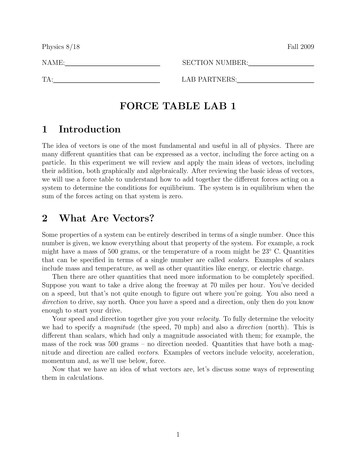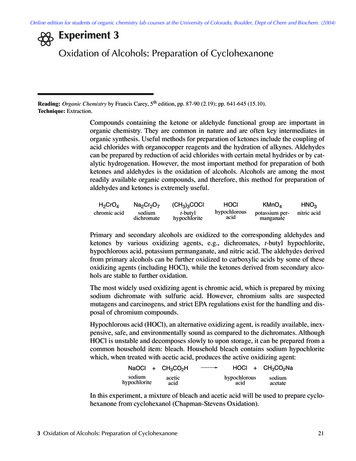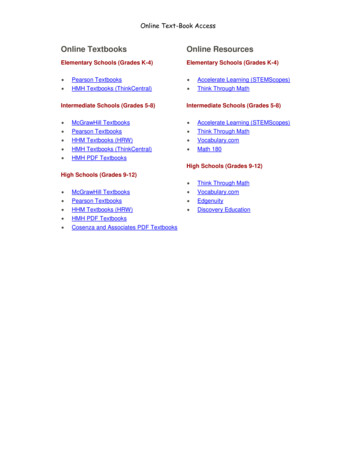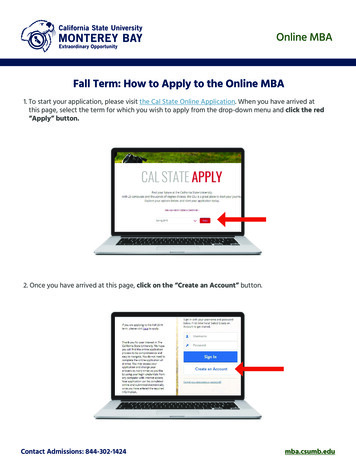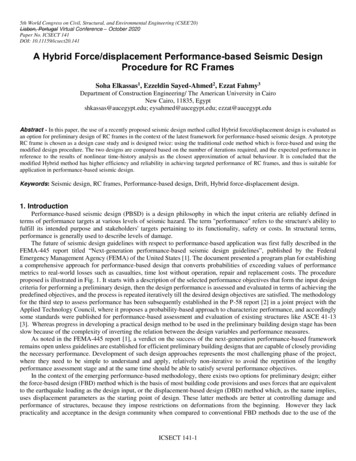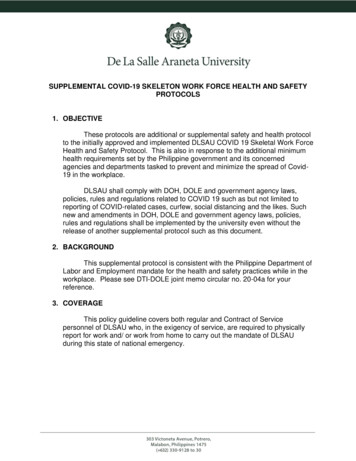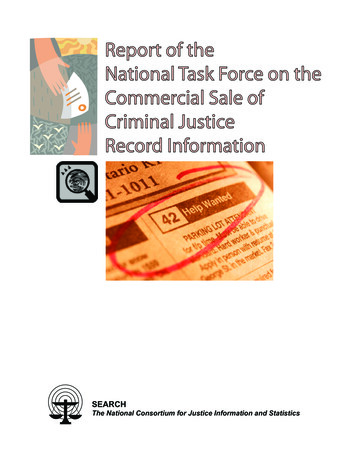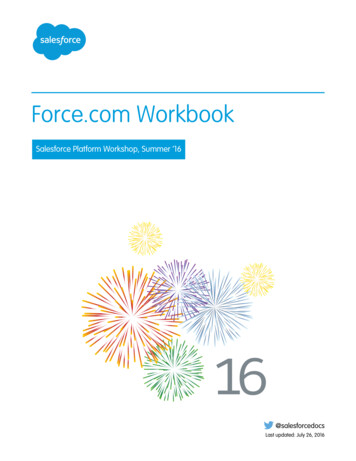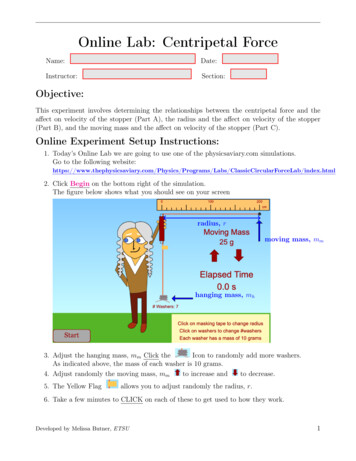
Transcription
Online Lab: Centripetal ForceName:Date:Instructor:Section:Objective:This experiment involves determining the relationships between the centripetal force and theaffect on velocity of the stopper (Part A), the radius and the affect on velocity of the stopper(Part B), and the moving mass and the affect on velocity of the stopper (Part C).Online Experiment Setup Instructions:1. Today’s Online Lab we are going to use one of the physicsaviary.com simulations.Go to the following rograms/Labs/ClassicCircularForceLab/index.html2. Click Begin on the bottom right of the simulation.The figure below shows what you should see on your screenradius, rmoving mass, mmhanging mass, mh3. Adjust the hanging mass, mm Click theIcon to randomly add more washers.As indicated above, the mass of each washer is 10 grams.4. Adjust randomly the moving mass, mmto increase andto decrease.5. The Yellow Flagallows you to adjust randomly the radius, r.6. Take a few minutes to CLICK on each of these to get used to how they work.Developed by Melissa Butner, ETSU1
Theory:According to Newton’s First Law, an object in motion tends to stay in motion in a straight lineat a constant speed if there is no external net force applied to the object. An object undergoinguniform circular motion (motion in a circle at constant speed) must be acted on by a non-zeronet force called the centripetal force which must point toward the center of the circle.The magnitude of the centripetal force required to keep an object in a circular path dependson the inertia (or mass) and the acceleration of the object, as you know from the second law2(F ma). The acceleration of an object moving in uniform circular motion is a vr , so themagnitude of the centripetal force of an object can be found frommv 2(1)rWhere (m) is the mass of the object moving in a circle in a circular orbit of radius (r) with atangential velocity (v). The distance (circumference) around a circle is 2πr. The velocity of anobject moving in a circular path can be found from v dt . For uniform circular motion, thetangential speed is given by:Fc 2πr(2)Twhere 2πr is the distance around one complete circle and T is the period (time) required to makeone revolution. Now if we substitute for v into Equation (1) yields:v mv 2Fc r 4π 2 mr2T 2r /24π 2 mrT 2 /r Fc 4π 2 mm rT2(3)For this experiment, mass mm is the mass of the moving mass moving at a constant tangentialspeed of vt at the end of a string of length r. The centripetal force will be supplied by a hangingmass mh that is attached to the bottom of the string. See the figure on page 1. The weight ofthis hanging mass is determined by the equation:Fw mh · g(4)Therefore, the weight of the hanging mass is the centripetal force applied to mass mm , keepingit in a horizontal circular orbit. Fc Fw or:vt2 mh g(5)rThus the calculated tangential velocity vtcalc required to keep this system in equilibrium, will be:rmhvtcalc rg(6)mmThe measured tangential velocity vtmeas is determined by:in rad/sec.vtmeas ω · r where (ω) is the angular velocity given by ω 2π/revT /revmmDeveloped by Melissa Butner, ETSU2
Part A - Relationship Between Force and Velocity1. Place a small number of washers ( 8) on the end of the string. Record your exact hangingmass, (mh ) which is the # of washers 10g in Row 1, Column 1 of Table 1.2. SET a radius of ( 200 cm) and mass of the moving mass, mm to a value in the range of60-90 g. Record your exact values in meters (m) and kilograms (kg) in the space provided.3. Click Start for 10 complete revolutions. Hit Pause. Record the time under the t1 columnof Table 1. Click Reset. Repeat 2 more times. Calculate and Record the average tavg .4. Click on the washers 1-2 times to add more mass. Record the exact (mh ) value in Table 1.Repeat Step 3. Then do this step 3 more times to complete Table 1.Table 1: Data - Relationship Between Force and VelocityRunmh (kg)t1 (s)t2 (s)t3 (s)tavg (s)12345mm (kg)r (m)Data Analysis:1. Calculate the Period, T for each run. Record your result in the Analysis Table.2. Calculate the angular velocity, ω for each run. Record your result in the Analysis Table.3. Calculate the measured tangential velocity, vtmeas ω r for each run.Record your result in the Analysis Table.4. Calculate the theoretical tangential velocity, vtcalc for each run using Equation 6.Record your result in the Analysis Table.5. Calculate the Centripetal Force, Fc for each run. Record your result in the Analysis Table.Table 2: Analysis - Relationship Between Force and VelocityRunT tavg10T (s)ω 2πTω (rad/s)vtmeas(m/s)vtcalc(m/s)Fc mh gFc (N)%error12345Developed by Melissa Butner, ETSU3
Part B - Relationship Between Radius and Velocity1. SET the radius to 30 cm. Record your exact radius, (r) in Row 1, Column 1 of Table 3.2. SET the hanging mass, mh to ( 150 g) and the moving mass, mm to ( 50 g).Record your exact values in meters (m) and kilograms (kg) in the space provided.3. Click Start for 10 complete revolutions. Hit Pause. Record the time under the t1 columnof Table 1. Click Reset. Repeat 2 more times. Calculate and Record the average tavg .4. Click on the yellow tab 1-2 times to increase the radius. Record the exact (r) value inTable 1. Repeat Step 3. Then do this step 3 more times to complete Table 1.Table 3: Data - Relationship Between Radius and VelocityRunr (m)t1 (s)t2 (s)t3 (s)tavg (s)12345mh (kg)mm (kg)Data Analysis:1. Calculate the Period, T for each run. Record your result in the Analysis Table.2. Calculate the angular velocity, ω for each run. Record your result in the Analysis Table.3. Calculate the tangential velocity, vt for each run.Record your result in the Analysis Table.4. Calculate the Centripetal Force, Fc for each run. Record your result in the Analysis Table.Table 4: Analysis - Relationship Between Radius and VelocityRunr (m)T tavg10T (s)ω 2πTω (rad/s)vt ω rvt (m/s)Fc mh gFc (N)12345Developed by Melissa Butner, ETSU4
Part C - Relationship Between Mass and Velocity1. SET the moving mass to 25 (g). Record the exact value in Row 1, Column 1 of Table 5.2. SET the hanging mass, mh to 150 g and the radius, r to 180 cm.Record your exact values in kilograms (kg) and meters (m) in the space provided.3. Click Start for 10 complete revolutions. Hit Pause. Record the time under the t1 columnof Table 1. Click Reset. Repeat 2 more times. Calculate and Record the average tavg .4. Click on the UP arrow to increase the moving mass. Record the exact (mm ) value inTable 1. Repeat Step 3. Then do this step 3 more times to complete Table 1.Table 5: Data - Relationship Between Mass and VelocityRunmm (kg)t1 (s)t2 (s)t3 (s)tavg (s)12345mh r Data Analysis:1. Calculate the Period, T for each run. Record your result in the Analysis Table.2. Calculate the angular velocity, ω for each run. Record your result in the Analysis Table.3. Calculate the tangential velocity, vt for each run.Record your result in the Analysis Table.4. Calculate the Centripetal Force, Fc for each run. Record your result in the Analysis Table.Table 6: Analysis - Relationship Between Mass and VelocityRunmm (kg)T tavg10T (s)ω 2πTω (rad/s)vt ω rvt (m/s)Fc mh gFc (N)12345Developed by Melissa Butner, ETSU5
Conclusions1. As centripetal force increases, the velocity (increases / decreases) .2. As the radius increases, the velocity (increases / decreases) .3. As the mass of the moving mass increases, the velocity (increases / decreases) .4. Use your analysis results in Table 2 to create a graph of the Centripetal ForceFc versus the measured tangential velocity vt2 .Upload it with this Lab Report in D2L. Comment on the graph.5. Use your analysis results in Table 4 to create a graph of r versus vt .Upload it with this Lab Report in D2L. Comment on the graph.6. Use your analysis results in Table 6 to create a graph of mm versus vt .Upload it with this Lab Report in D2L. Comment on the graph.7. Discuss how well your measured vt values (vtmeas ) compared to the theoretical vt values(vtcalc ) from Table 2. Compare the measured values with the theoretical values using theequation below. Record your results in Column 7 of Table 2. vtmeas vtcalc%Error 100(7)vtcalc8. Take a photo or scan a copy showing ALL calculations performed during this laband upload it with this Lab Report in D2L.Developed by Melissa Butner, ETSU6
4. Use your analysis results in Table 2 to create a graph of the Centripetal Force F c versus the measured tangential velocity v2 t. Upload it with this Lab Report in D2L. Commentonthegraph. 5. Use your analysis results in Table 4 to create a graph of rversus v t. Upload it with this Lab Report in D2L. Commentonthegraph. 6. Use your analysis .
